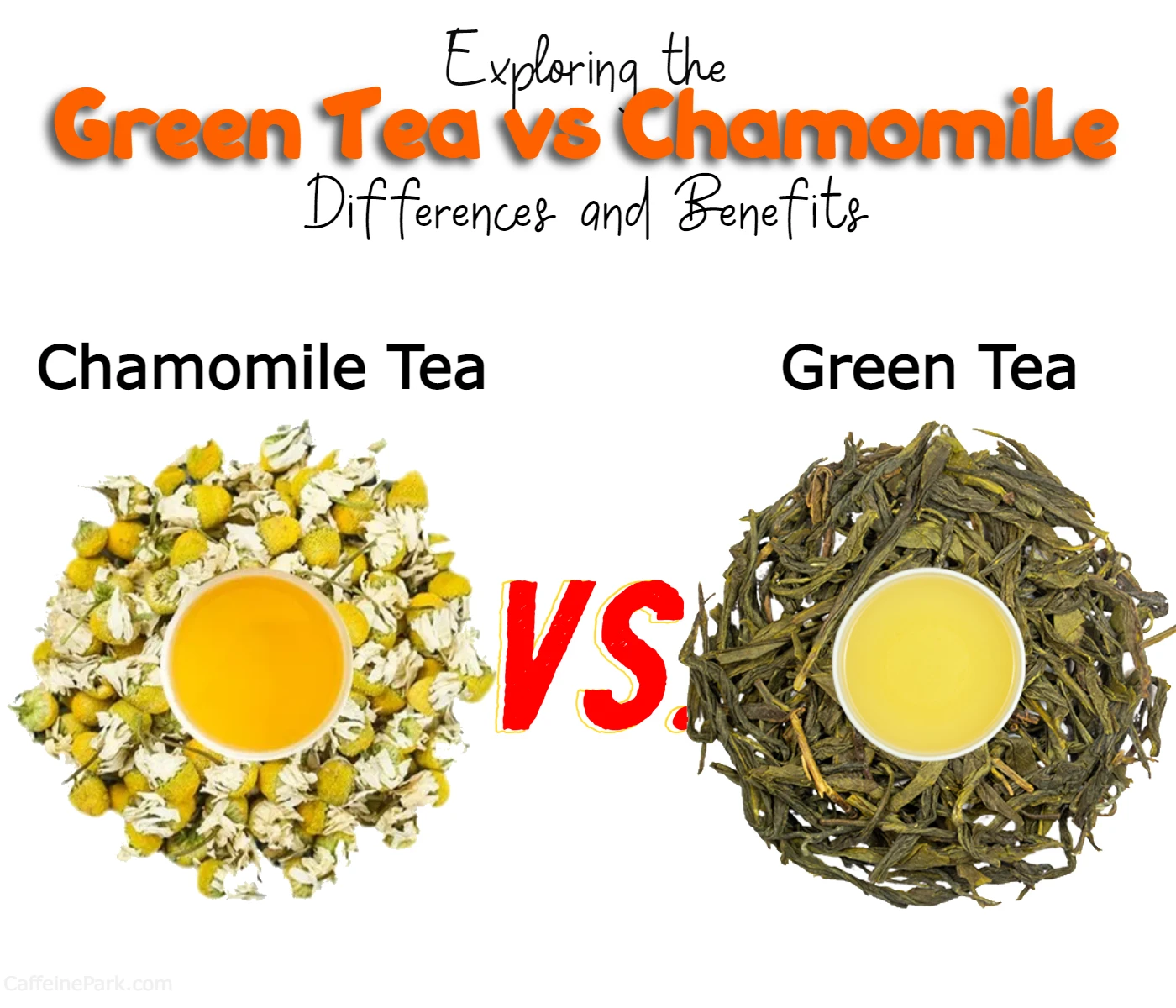
Are you a tea lover who’s always on the lookout for new and exciting teas to try? If so, you’ve probably heard of green tea and chamomile tea. These two popular teas have different flavor profiles and unique health benefits, making them a favorite among tea enthusiasts.
But what exactly is the difference between green tea and chamomile tea? And which one is right for you? In this blog post, we’ll dive into the details and explore the differences between these two popular teas. Whether you’re looking for a tea packed with antioxidants or a soothing tea to help you unwind after a long day, we’ve got you covered.
So, grab a cup of your favorite tea and settle in as we explore the difference between green tea and chamomile tea. And be sure to read to the end of this blog post for a special call to action that will help you make the most of your tea-drinking experience.
Here’s a quick chart outlining some of the key differences between green tea and chamomile:
| Green Tea | Chamomile | |
|---|---|---|
| Flavor | Earthy, vegetal, slightly bitter | Mild, floral, slightly sweet |
| Caffeine content | Moderate to high | None |
| Antioxidants | High | Low |
| Health benefits | Boosts metabolism, promotes weight loss, supports heart health | Promotes relaxation, reduces stress and anxiety, aids digestion |
| Best consumed | Morning or early afternoon | Evening or before bed |
Keep in mind that these are generalizations and individual tea brands may have variations in flavor and caffeine content. It’s always a good idea to read the label and do your research to find the best tea for your needs.
Difference between green tea and chamomile tea
What is Green Tea?
Green tea is made from the leaves of the Camellia sinensis plant. The leaves are steamed or pan-fried after they’re picked, which stops the oxidation process that turns the leaves brown and results in black tea. This minimal processing is what gives green tea its unique flavor and health benefits.
What is Chamomile Tea?
Chamomile tea is made from the dried flowers of the chamomile plant. The flowers are steeped in hot water to release their flavor and medicinal properties. Chamomile tea is known for its calming and soothing effects, making it a popular choice for bedtime.
Taste
When it comes to taste, green tea and chamomile are very different. Green tea has a grassy, slightly bitter taste with a hint of sweetness. Some people describe it as a “vegetal” or “nutty” flavor. Chamomile tea, on the other hand, has a mild, floral taste with a hint of apple. It’s often described as “soothing” or “relaxing.”
Caffeine Content
One of the biggest differences between green tea and chamomile is its caffeine content. Green tea contains caffeine, although less than black tea or Type of coffee. The amount of caffeine in green tea can vary depending on the brand and how it’s brewed, but on average, an 8-ounce cup of green tea contains around 20-50 mg of caffeine.
Chamomile tea, on the other hand, is caffeine-free. This makes it a great choice for people who are sensitive to caffeine or who want to avoid it altogether.
Health Benefits
Both green tea and chamomile have numerous health benefits, although they’re different in nature.
Health Benefits of Green Tea
Green tea is rich in antioxidants called catechins, which have been shown to have numerous health benefits. Here are just a few of the ways that green tea may be good for your health:
- May reduce the risk of cardiovascular disease
- May lower blood pressure
- May improve brain function
- May reduce the risk of certain types of cancer
- May aid in weight loss
Health Benefits of Chamomile Tea
Chamomile tea is also packed with health benefits, although they’re different from those of green tea. Here are some of the ways that chamomile tea may be good for your health:
- May improve sleep quality and help with insomnia
- May reduce inflammation
- May soothe digestive issues, such as upset stomach or irritable bowel syndrome (IBS)
- May boost the immune system
- May have a calming effect and help reduce anxiety
Uses
Green tea and chamomile are used in different ways, both for drinking and for other purposes.
Green Tea Uses
Green tea is most commonly consumed as a beverage, either hot or cold. It’s also used in cooking and baking, particularly in Asian cuisine. Additionally, green tea extract is used in supplements, skincare products, and other health products.
Chamomile Tea Uses
Chamomile tea is primarily consumed as a beverage, particularly before bed to promote relaxation and better sleep. It’s also used in skincare products, particularly for its soothing properties.
Side Effects and Precautions
While both green tea and chamomile are generally safe for most people, there are some precautions you should be aware of.
Side Effects and Precautions: Green Tea
Green tea contains caffeine, which can cause side effects such as jitteriness, headaches, and trouble sleeping if consumed in large amounts. Additionally, green tea can interact with certain medications, so it’s important to talk to your doctor before adding it to your routine if you’re taking any prescription drugs.
Side Effects and Precautions: Chamomile Tea
Chamomile tea is generally safe for most people, although some people may experience an allergic reaction if they’re allergic to plants in the same family as chamomile (such as ragweed or daisies). Additionally, chamomile can interact with certain medications, so it’s important to talk to your doctor before adding it to your routine if you’re taking any prescription drugs.
Chamomile vs Green Tea Weight Loss
Both chamomile tea and green tea have been suggested to aid in weight loss, but there is limited scientific evidence to support these claims.
Green tea contains caffeine and catechins, which are compounds that have been shown to increase metabolism and promote fat burning. Some studies suggest that drinking green tea may help with weight loss when combined with a healthy diet and exercise.
Chamomile tea, on the other hand, is not typically associated with weight loss. It is often consumed for its calming effects and may help with reducing stress, and anxiety, and improving sleep quality. While chamomile tea does not directly aid in weight loss, it may indirectly support weight management by reducing stress-related eating.
Overall, both chamomile tea and green tea can be part of a healthy diet, but it is important to keep in mind that no single food or beverage can cause significant weight loss on its own. Weight loss is best achieved through a combination of healthy eating habits, regular physical activity, and a balanced lifestyle.
Which One is Better?
So, which one is better: green tea or chamomile? The answer is that it depends on what you’re looking for.
If you’re looking for a tea with a mild, soothing flavor that can help you relax and get better sleep, chamomile tea is the way to go. On the other hand, if you’re looking for a tea that’s packed with antioxidants and may offer numerous health benefits, green tea is the better choice.
Ultimately, both green tea and chamomile have their own unique benefits and drawbacks, and the best choice depends on your personal preferences and health goals. Luckily, both teas are widely available and easy to incorporate into your routine, so you can enjoy the benefits of both!
Conclusion
In conclusion, green tea and chamomile are two popular teas with very different flavor profiles and health benefits. While green tea is packed with antioxidants and may offer numerous health benefits, chamomile is known for its soothing and calming effects. Both teas are widely available and easy to incorporate into your routine, so try them both and see which one you prefer! And as always, be sure to talk to your doctor before adding any new foods or supplements to your routine, especially if you have any health concerns or are taking any medications.
FAQs
Yes, you can consume green tea and chamomile together if you like. However, keep in mind that green tea contains caffeine while chamomile is a natural sedative, so the effects of each tea may counteract each other.
Green tea is known to contain compounds that can boost metabolism and promote weight loss, so it’s often recommended for people who want to lose weight. Chamomile, on the other hand, doesn’t have the same weight loss benefits as green tea.
While both green tea and chamomile are generally safe to consume during pregnancy, it’s always best to consult with your doctor before adding any new foods or supplements to your diet while pregnant.
Chamomile is known for its calming and soothing effects, so it’s often recommended for people who want to reduce stress and anxiety. Green tea may also have stress-reducing properties due to its high antioxidant content, but chamomile is generally considered more effective for this purpose.
Both green tea and chamomile have been shown to have beneficial effects on digestion. Green tea may help stimulate digestion and reduce inflammation in the digestive system, while chamomile can help relax the muscles in the digestive tract and relieve bloating and gas.
Chamomile is often recommended as a bedtime tea due to its calming effects and ability to promote better sleep. Green tea, on the other hand, should be consumed in moderation before bed as it contains caffeine which can interfere with sleep.
Green tea contains antioxidants that can help protect the skin from damage caused by free radicals and UV rays, and may also help improve skin elasticity and reduce inflammation. Chamomile may also have some skin benefits, such as reducing inflammation and irritation.
Chamomile has anti-inflammatory properties that may help relieve allergy symptoms, such as itching and swelling. Green tea may also have some benefits for allergies due to its high antioxidant content and anti-inflammatory properties. However, more research is needed to confirm these effects.
Read More:
Source:





